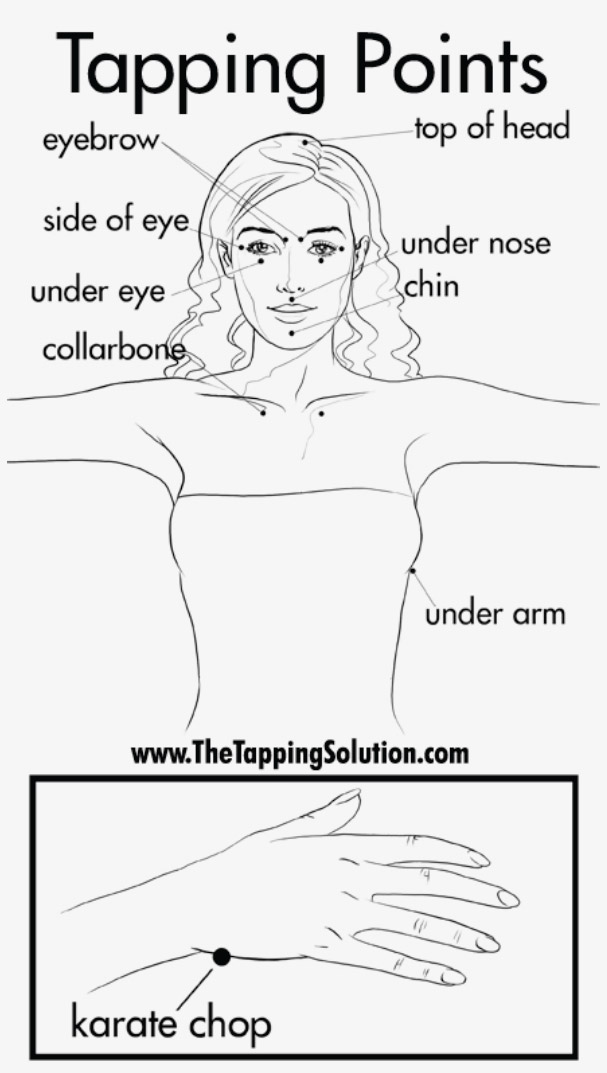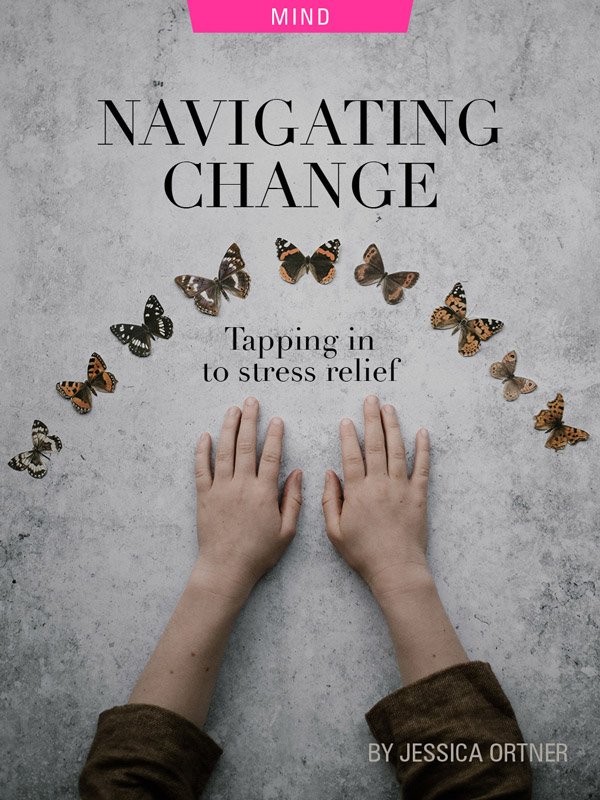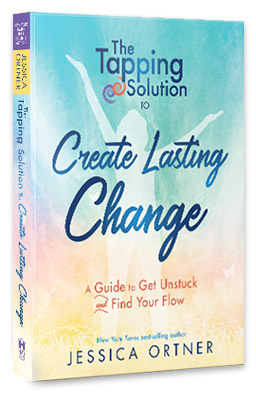How to use EFT tapping to help navigate change by relieving associated stress
—
Our relationship with change is complicated. We want to reach for greater goals, greater relationships, greater health, greater abundance, but according to the primitive brain, any change is perceived as unsafe — even positive change.
That might seem counterintuitive when we’re talking about change that will feel good and get us unstuck, but this is the primitivebrain we’re talking about. Its programming is basic and primal, so it doesn’t differentiate between positive and negative change.
Across the board, the brain prefers the certainty of your current experience (which it sees as safe, simply because you’re still alive) over the uncertainty of change (which it sees as unsafe, simply because it’s unknown). When we attempt to grow, expand, and evolve, the primitive brain rushes in to protect us from potential new threats. It fires off warning signals, telling the brain and body that we are unsafe.
That’s why change feels so hard — because the brain and body are working against us when we most need their support.
The Pattern of Panic
That’s how the pattern of panic works. We think we should be further along by now or ‘better’ than we are, so we panic. We beat ourselves up and use our shame to motivate action. And this works, initially. We muster all the self-discipline we can to do things differently and force ourselves into new habits. But as soon as we step out of our comfort zone our brain and body panic and we have to fight tooth and nail for that change every step of the way. Because we can only keep that fight up for so long, we go back to our old ways, only to beat ourselves up again and repeat the pattern indefinitely.
My own pattern of panic began when I was 14-years-old and just starting my first diet. Desperate to transform my body, I’d follow a strict plan and lose some weight. Eventually, though, I’d get exhausted and resort to my old habit of binge eating. Standing in front of the cupboard, consuming entire boxes of ‘healthy’ bars and nuts, I felt relieved, even empowered. I was rebelling, taking my power back from a society that seemed ashamed of me for not being a size 2.
Soon, though, my elation would turn into regret and disappointment. Feeling defeated, I’d then find a new, even better fad diet, an even moreeffective fat-burning exercise routine to follow.
Each time I cycled through this pattern, I told myself that if I really, really, really wanted to lose weight, my desperation would be strong enough to make me change.
I told myself that I couldn’t let up, that I had to be hard on myself.
I soon became a self-help junkie. I read books and attended seminars, feverishly looking for someone to tell me how to end my struggle. The more I focused on ‘fixing’ myself, the more flaws I found. The more I read, the more pressure I felt to do things perfectly.
My initial struggle was with my body and self-image. Maybe you can relate. Or perhaps you feel stuck when it comes to your finances, your relationship status, or your career path. When we are faced with a struggle, something we desperately want to change — we stress, and as we try to change, our bodies react with even more stress.
The Stress Relief Secret
The secret to creating change with more ease is to address that stress. By calming our natural stress response, we are more able to think creatively, act resourcefully, and connect to our intuition to know what’s right for us.
This is where Tapping comes into the picture.
‘Tapping’ (also known as Emotional Freedom Technique or EFT) is a stress relief practice based on ancient Chinese acupressure points and modern psychology. Tapping on acupressure points while you focus on your stress sends a calming signal to the brain making it possible to relax. Think acupuncture but without the needles.
Let’s jump in with a quick tapping exercise to address the critical voice we often use to motivate change. And let’s get really honest from the get-go. If hating yourself happy worked, millions of us would be living in a state of perpetual ecstasy. We would have hated ourselves happy years ago!
The truth is that our critical voice doesn’t make us happy or help us get unstuck. Instead, it keeps us cycling through the pattern of panic, disconnected from our flow and our joy and unable to make positive changes that last.
So, let’s tap on it.
Tapping Exercise: Quieting Your Critical Voice
Close your eyes and focus your attention on what your critical voice says to you most often. As you do that, mentally scan your body. Notice any sensations you feel. These are ways that your body is reacting to your critical voice.
Focus on the primary one or two emotions you feel most intensely in response to your critical voice. Rate the intensity of that emotion on a scale of 0 to 10, with 10 being the highest intensity you can imagine.
With your primary emotion(s) in mind, start tapping.
As you tap through the rounds, feel free to substitute words that reflect your experience. Also be aware of how your experience shifts during and after tapping.

Take a deep breath. Begin tapping on the Karate Chop point.
Karate Chop (repeat three times): Even though my critical voice is saying these harsh things to me, I accept myself and choose to relax now.
Eyebrow: I’m so hard on myself
Side of Eye: My critical voice
Under Eye: It’s always there
Under Nose: Ready to bring me down
Under Mouth: These things I say to myself
Collarbone: I’d never say them to a scared child
Under Arm: I’d never say them to a loved one
Top of Head: I’m so hard on myself
Eyebrow: I’ve been self-critical for so long
Side of Eye: And part of me doesn’t think I can change
Under Eye: Part of me listens to this voice
Under Nose: Because I think it’ll help
Under Mouth: I’ve been trying to hate myself happy
Collarbone: I’ve been trying to criticize myself to change
Under Arm: I acknowledge the pain this has caused me
Top of Head: And how stuck I feel
Eyebrow: I acknowledge my critical voice
Side of Eye: And all the anxiety that comes with it
Under Eye: All this self-criticism
Under Nose: It’s hard to live with
Under Mouth: It makes me anxious
Collarbone: It makes me panic
Under Arm: I’m tired of fighting my critical voice
Top of Head: I’m open to a new way
Eyebrow: I begin to notice when I hear my critical voice
Side of Eye: I notice how I feel
Under Eye: Am I scared or overwhelmed?
Under Nose: I acknowledge the emotions behind this voice
Under Mouth: I honor my feelings
Collarbone:I honor how hard this has been
Under Arm: I don’t need to fight my critical voice
Top of Head: I simply honor how I feel
Eyebrow:I allow my body to relax
Side of Eye: This critical voice is simply an invitation
Under Eye: To practice kindness and self-compassion
Under Nose: I release the need to fight it
Under Mouth: I remember that I am safe
Collarbone: I don’t need to believe
Under Arm: Everything that I think
Top of Head: I give my body permission to relax
Eyebrow: As I feel centered in my body
Side of Eye: I choose to be a good friend to myself
Under Eye: I have my own back
Under Nose: I nurture my spirit with positive thoughts
Under Mouth: I am in control of what I focus on
Collarbone: I focus on my gifts
Under Arm: I have so much to share with this world
Top of Head: I clear my path with encouraging thoughts
Take a deep breath. Check back in with yourself, notice the intensity of your panic response now, and rate it again on a scale of 0 to 10. Repeat this script (or create your own) — don’t get caught up in the words, just feel your way through it. Say the words that resonate with you, the ones that will talk back to your fears. This is how you can shift old patterns of behavior and simultaneously ease your entire being.
As you begin to relax and disconnect from the pattern of panic and your critical voice, you’ll be able to contemplate positive action to create change not from a place of desperation and fear, but rather from a place of peace and clarity.
You may also enjoy Interview: Nick Ortner | The Tapping Solution with Kristen Noel

